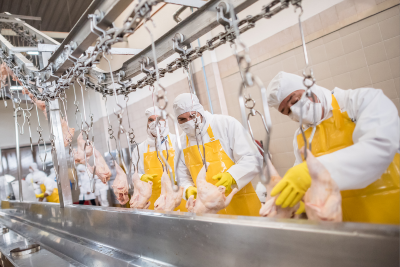The average American consumes more than 100 pounds of poultry every year. In 2017, U.S. poultry production totaled 9 billion chickens and 241.7 million turkeys. Behind every piece of poultry brought to the market is a safety professional working to implement measures to protect the workers processing the poultry as well as the consumers eating it.
U.S. poultry production totaled 9 billion chickens and 241.7 million turkeys. Behind every piece of poultry brought to the market is a safety professional working to implement measures to protect the workers processing the poultry as well as the consumers eating it.
Here are just a few ways that safety professionals help keep workers safe while processing poultry before it reaches your table.
Sanitation and Slip Prevention
In any food preparation, sanitation is critical. Processing must take place in an environment that is clean for both workers and the products they are handling. To address this, processing plants are rigorously cleaned at the end of every shift.
Prior to each shift changeover, walls, floors and equipment are disinfected and sanitized. While this daily cleaning process sterilize equipment to help protect workers and poultry products, it creates a wet working environment, which increases slip, trip and fall hazards.
Therefore, safety professionals must verify that floors drain properly to remove excess water. They must also make sure that floors are treated with special coatings and that PPE such as rubber boots or protective shoes provide a proper level of slip resistance.
In addition, given chlorine-based chemicals are often used in the cleaning process, a facility should be properly ventilated and workers trained to properly handle those substances.
Chemical Handling and Labeling
In addition to sanitation, chemicals help ensure that poultry is free of foodborne illnesses such as salmonella. However, the presence of any chemicals in a workplace presents the challenge of making sure those chemicals are labeled and handled properly.
To help prevent foodborne illness, chemicals may be applied to the poultry in a spray booth, a water mixture or a dip tank. Regardless of the method, these areas should be properly ventilated and workers properly trained on chemical handling and equipped with PPE to prevent contact with the chemicals.
It is also important to take measures to prevent chemical spills and keep incompatible chemicals from interacting. For example, hydrogen ammonia leak can occur in refrigerated areas. Some chemicals are oxidizers and must be stored away from combustible materials.
When not being used within the processing plant, chemicals should be stored in an off-production location that is well ventilated and that the facility and chemicals are properly labeled. Workers that access storage areas should be trained to properly handle each chemical.
Proper Ergonomics and PPE
Poultry processing work involves extended standing, as well as repetitive hand and arm motions. While some tasks are now automated, many poultry processing tasks are still performed manually, with workers handling and cutting poultry with knives as it moves along a conveyor belt. These repetitive motions can affect a worker’s hands, arms and shoulders, so an understanding of proper ergonomic techniques is crucial to a worker’s overall well-being.
A de-bone line, where poultry is cut into different pieces, may include 20 to 30 workers each performing a different cut on a piece of poultry. With so many workers using knives in close proximity, the safety professional needs to focus on measures to make sure workers don’t cut themselves and that their arm movements do not harm their coworkers.
Given this type of working atmosphere, U.S. Poultry and Egg Association’s director of human resources and safety programs Matt Spencer, CSP, says safety professionals should constantly be monitoring the work environment, looking for any process disruptions and how they could affect workers.
“You have workers using sharpened knives for making various cuts in the product that requires proper training. This includes training to ensure individuals make cuts in a way that do not infringe on a co-worker’s space” says Spencer. “Are they wearing all the proper PPE?
Given the critical role of PPE in slip prevention and hand protection, be sure to periodically inspect equipment to ensure that it continues to provide an appropriate level of protection, Spencer advises.
“A common practice is to have supervisors, line leads and others periodically check for wear and tear on employee’s PPE to make sure that it’s withstanding the environment and replace it quickly if there are any deficiencies,” says Spencer.
With all of these elements at play, effective training can mean the difference between worker safety and serious injuries. Therefore, safety professionals should regularly communicate the hazards and risks to workers and explain how to mitigate those dangers.
“We have many different cultures represented in the industry, so it’s crucial that training materials are translated in a way that is comprehensible for workers,” says Spencer. “We have to ensure that workers understand training materials, that they understand the necessity of PPE and the rules as well as the rules and requirements that are set forth for them.”
The efforts of safety professionals in poultry processing have proven successful as injuries and illnesses in the industry reached an all-time low in 2018 and have fallen 84 percent over the past 25 years. Furthermore, the industry’s injury rate of 3.5 cases per 100 full-time workers was lower than that of similar agricultural industries and the food manufacturing sector as a whole.
The U.S. Poultry and Egg Association offers training resources on poultry processing safety issues including knife safety, lockout/tagout, machine guarding and spill prevention. The organization also has a series of posters and videos to help demonstrate proper ergonomics such as correct posture and to help workers recognize symptoms of musculoskeletal disorders.
Understanding Risk Management and Assessment
We have the resources and expert guidance you need to improve how you assess risks to prevent hazards, protect workers and safeguard equipment.
Learn more